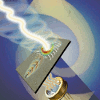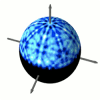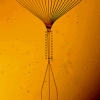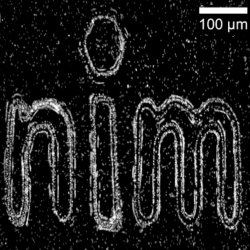-
Viewpoint on 'IONS'
Viewpoint on 'Scientific Literacy'
- Proudly sponsored by
-


-
A New Twist to Optical Detectors

A new arrival in the family of optical detectors gives a new twist to the detection of the orbital angular momentum of light. This could make classical and quantum optical communications even easier.
-
A Close Up on Matter

The deeper we try to look into matter, the larger the experimental facilities seem to become. Paddling against the flow, a new technique from Japan could soon make 3D atomic images affordable by any small laboratory around the world.
-
The Random Walk towards Quantum Computing

Subtle quantum effects will be at the heart of the quantum computers of the future. Very few existing setups, however, offer the necessary stability and control to exploit such effects at the moment. Arrays of waveguides meet this challenge.
Volume 5 Story 3 - 26/5/2009

Imagine a chemistry or biology lab — a room full of test tubes, flasks and stirrers constantly rearranged by adroit scientists to perform a variety of analysis. Now imagine shrinking it down to the size of a chip – the lab-on-a-chip, that is. This vision is gradually becoming a practical reality. One of the remaining challenges is how to have a reconfigurable lab-on-a-chip. One possibility is to use ice-chips illuminated by light, as proposed by Dieter Braun and co-workers at Ludwig Maximilians Universität München (Germany).
Shrinking down an entire lab to the size of a chip is part of the general trend of modern technology — from cell-phones to computers — towards miniaturization and presents many advantages —for example, a marked reduction of the costs for chemical and biological analysis that could bring healthcare and improved environmental standards to a larger community.
Obviously making miniature labs is not just a question of scaling down conventional equipment. For example, in standard room-scale labs there are scientists or computers taking care of dynamically reconfiguring the interconnections between the various equipments. This allows one to perform multiple tasks using the same lab and to dynamically decide which analysis to perform. This is not as easy dealing with a lab-on-a-chip. Indeed, we do have the technology to build a chip with an arbitrarily complicated network of microscopic channels. This is typically done by photo-lithography — a technique similar to developing a photograph, which, for example, is commonly employed in the fabrication of silicon-chips. However, this naturally leads to a prefixed set of channels, which, just like a photograph, are not supposed to change over time.
As a more practical alternative to the improbable idea of shrinking down the scientists to a sub-millimetre size, the use of ice-chips with a dynamically reconfigurable network of channels has been proposed by Braun and co-workers. The idea is fairy simple. By focusing an infrared laser on a micrometer thin ice sheet it is possible to locally raise its temperature. This leads to a pressure decrease – the melted water has a smaller volume than the ice, as the experience of a floating iceberg tells us. If the laser spot is moving, the ice melts at the laser spot and freezes again behind it. The result is a fluid flow in the molten ice in the direction of the moving spot induced by the pressure gradient. This effectively creates a dynamical channel along which minute quantities of liquids can be transported.
Similar ideas were explored by Braun and co-workers in some previous works [1]. The novelty of their latest work lies in using the ice-water transition to enhance the pump effect. "We had already moved water around [1]," explains Braun, "essentially using viscosity changes. Then we thought about how to get huge viscosity changes and we realized that it would happen near a phase transition such as water-ice. Actually it would also happen at other phase-transitions, for example between liquid and gas."
Such a technique presents great advantages over other microfluidic techniques. What is the main advantage? "It's simplicity," is Braun’s answer. "Other microfluidics techniques require a lot of interface with the outside: pumps, valves, defined pressure, etc. Some of these things you don't need when you work with light. Plus, hopefully, the cost of infrared lasers is going down fast because of its use in telecommunications."
In principle, even 3-dimensional fluxes could also be possible. "If you can implement local heating in bulk, such as with a 2-photon absorption technique," envisions Braun. "However, the presence of a thick sample slows down heating and cooling quadratically. For example, for a sample 100μm thick the time-scales are 100 times longer than for a sample 10μm thick! Therefore the technique is much more effective for thin samples."
The possible applications of the newly developed technique are broad and go beyond the dynamical creation of a network of microchannels. For example, one of the most prominent problems dealing with liquids at the microscale is to get them to mix together. We are accustomed to pouring milk in our coffee or tea and we expect to get a perfect mixture with just a few stirs of our spoons, due to the turbulent flow we create – just get a coffee or tea and try it out! However, nanolitre volumes of liquid behave in odd ways [2], in particular there is no such turbulence in micrometre-sized channels: streams of coffee and milk flow alongside each other over without mixing, almost as if they were separated by glass. "We are now trying different geometries with different liquids at the same time," explains Braun, "it might be useful for mixing, biological mixing and accumulation reactions." Two liquids could be forced to mix under the pressure difference.
Other possible applications lie at the border with molecular biology, but it still remains an unanswered question of how to apply this technique to living cells. "Ours is an amorphous state," explains Braun, "therefore the coordinates of the molecules are preserved and as such it permits one to preserve the structure of the biomolecules. First biomolecules, such as DNA, then maybe cells. I am not completely sure: the ultimate stress might be too much."
[1] F. M. Weinert et al., Microscale Fluid Flow Induced by Thermoviscous Expansion Along a Traveling Wave, Phys. Rev. Lett. 100, 164501 (2008).
[2] E.M. Purcell, Life at Low Reynolds Number, Am. J. Phys. 45, 3-11 (1977).

The Ice Age of Microfluidics
The vision of shrinking a full lab into a chip is gradually becoming a reality. Now the possibility to dynamically generate microchannels with a laser spot in a slab of ice opens new possibilities towards a reconfigurable lab-on-a-chip.
Dynamically generated micro-channels. An arbitrary array of channels — in this case the letters "nim" — can be generated in a thin ice-slab by a moving laser spot.
Shrinking down an entire lab to the size of a chip is part of the general trend of modern technology — from cell-phones to computers — towards miniaturization and presents many advantages —for example, a marked reduction of the costs for chemical and biological analysis that could bring healthcare and improved environmental standards to a larger community.
Obviously making miniature labs is not just a question of scaling down conventional equipment. For example, in standard room-scale labs there are scientists or computers taking care of dynamically reconfiguring the interconnections between the various equipments. This allows one to perform multiple tasks using the same lab and to dynamically decide which analysis to perform. This is not as easy dealing with a lab-on-a-chip. Indeed, we do have the technology to build a chip with an arbitrarily complicated network of microscopic channels. This is typically done by photo-lithography — a technique similar to developing a photograph, which, for example, is commonly employed in the fabrication of silicon-chips. However, this naturally leads to a prefixed set of channels, which, just like a photograph, are not supposed to change over time.
As a more practical alternative to the improbable idea of shrinking down the scientists to a sub-millimetre size, the use of ice-chips with a dynamically reconfigurable network of channels has been proposed by Braun and co-workers. The idea is fairy simple. By focusing an infrared laser on a micrometer thin ice sheet it is possible to locally raise its temperature. This leads to a pressure decrease – the melted water has a smaller volume than the ice, as the experience of a floating iceberg tells us. If the laser spot is moving, the ice melts at the laser spot and freezes again behind it. The result is a fluid flow in the molten ice in the direction of the moving spot induced by the pressure gradient. This effectively creates a dynamical channel along which minute quantities of liquids can be transported.
Similar ideas were explored by Braun and co-workers in some previous works [1]. The novelty of their latest work lies in using the ice-water transition to enhance the pump effect. "We had already moved water around [1]," explains Braun, "essentially using viscosity changes. Then we thought about how to get huge viscosity changes and we realized that it would happen near a phase transition such as water-ice. Actually it would also happen at other phase-transitions, for example between liquid and gas."
Such a technique presents great advantages over other microfluidic techniques. What is the main advantage? "It's simplicity," is Braun’s answer. "Other microfluidics techniques require a lot of interface with the outside: pumps, valves, defined pressure, etc. Some of these things you don't need when you work with light. Plus, hopefully, the cost of infrared lasers is going down fast because of its use in telecommunications."
In principle, even 3-dimensional fluxes could also be possible. "If you can implement local heating in bulk, such as with a 2-photon absorption technique," envisions Braun. "However, the presence of a thick sample slows down heating and cooling quadratically. For example, for a sample 100μm thick the time-scales are 100 times longer than for a sample 10μm thick! Therefore the technique is much more effective for thin samples."
The possible applications of the newly developed technique are broad and go beyond the dynamical creation of a network of microchannels. For example, one of the most prominent problems dealing with liquids at the microscale is to get them to mix together. We are accustomed to pouring milk in our coffee or tea and we expect to get a perfect mixture with just a few stirs of our spoons, due to the turbulent flow we create – just get a coffee or tea and try it out! However, nanolitre volumes of liquid behave in odd ways [2], in particular there is no such turbulence in micrometre-sized channels: streams of coffee and milk flow alongside each other over without mixing, almost as if they were separated by glass. "We are now trying different geometries with different liquids at the same time," explains Braun, "it might be useful for mixing, biological mixing and accumulation reactions." Two liquids could be forced to mix under the pressure difference.
Other possible applications lie at the border with molecular biology, but it still remains an unanswered question of how to apply this technique to living cells. "Ours is an amorphous state," explains Braun, "therefore the coordinates of the molecules are preserved and as such it permits one to preserve the structure of the biomolecules. First biomolecules, such as DNA, then maybe cells. I am not completely sure: the ultimate stress might be too much."
[1] F. M. Weinert et al., Microscale Fluid Flow Induced by Thermoviscous Expansion Along a Traveling Wave, Phys. Rev. Lett. 100, 164501 (2008).
[2] E.M. Purcell, Life at Low Reynolds Number, Am. J. Phys. 45, 3-11 (1977).
Giovanni Volpe
2009 © Optics & Photonics Focus
GV is currently working as a postdoctoral researcher at the Max Planck Institute in Stuttgart (Germany).

Franz M. Weinert, Max Wühr, and Dieter Braun, Light driven microflow in ice, Applied Physics Letters (2009) 94, 113901 (link).